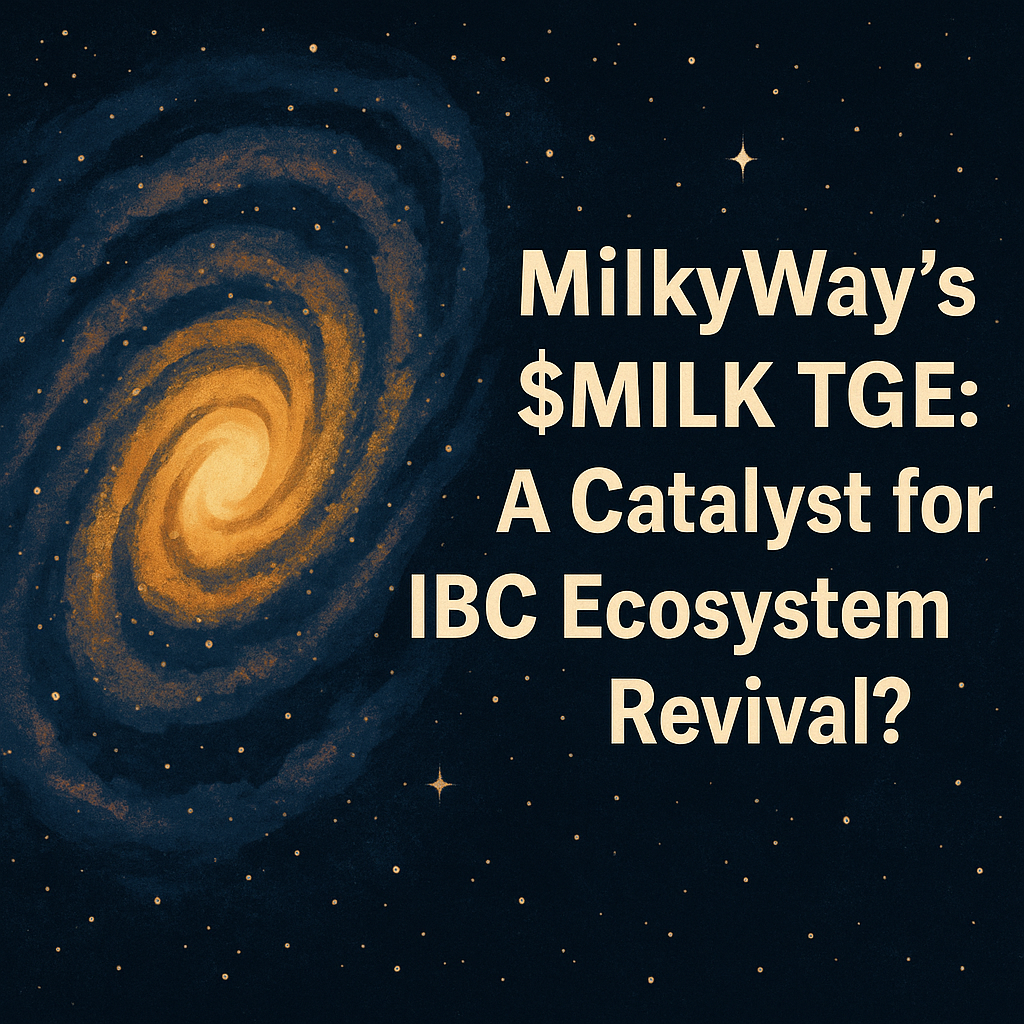MilkyWay’s $MILK TGE: A Catalyst for IBC Ecosystem Revival?

What is IBC?
The Inter-Blockchain Communication (IBC) protocol, a cornerstone of the Cosmos ecosystem, has long been celebrated for its ability to enable seamless interoperability between sovereign blockchains. By facilitating trustless token transfers and arbitrary data exchange, IBC has connected over 45 blockchains, fostering a vibrant interchain economy. However, as the broader blockchain landscape evolves, with modular architectures and cross-chain solutions gaining traction, the IBC ecosystem faces challenges such as fragmented liquidity, competition from alternative bridging solutions, and the need for enhanced capital efficiency.
MilkyWay, a modular staking and restaking protocol, and its $MILK Token Generation Event (TGE), scheduled for April 29, 2025. Due to its innovative approach to liquid staking and restaking, MilkyWay’s $MILK TGE has sparked discussions about its potential to breathe new life into the IBC ecosystem. This article explores if and how the $MILK TGE could revitalize IBC, examining its technological innovations, economic incentives, and broader implications for interoperability.
Understanding MilkyWay and the $MILK TGE
MilkyWay, launched in December 2023, is the first and largest liquid staking and restaking protocol within the modular blockchain ecosystem, initially built for the Celestia blockchain and deployed on Osmosis, a leading decentralized exchange (DEX) in the Cosmos ecosystem. MilkyWay allows users to stake assets like Celestia’s $TIA or Initia’s $INIT without locking them, receiving liquid staking tokens (e.g., milkTIA) that can be used across DeFi platforms for trading, lending, or yield farming. Its restaking feature further enhances capital efficiency by allowing staked assets or liquid staking tokens to secure additional services, known as Actively Validated Services (AVSs), earning users extra rewards.
The $MILK token, the native governance token of the MilkyWay ecosystem, is set to debut through a highly anticipated TGE. Hosted via partnerships with major platforms like Binance Wallet and PancakeSwap, the TGE allocates 10% of the total $MILK supply (100 million tokens) to early adopters, including mPoints holders, Moolitia NFT holders, and milkINIT testers. The mPoints system, which ended on February 28, 2025, rewarded users for activities like staking, bridging, and referrals, fostering community engagement. Additionally, 20 million $MILK tokens are earmarked for post-TGE marketing to drive adoption. With a total value locked (TVL) of $190 million and integrations with over 10 DeFi protocols, including Osmosis, Levana, and Mars, MilkyWay is well-positioned to make a significant impact.
The State of the IBC Ecosystem
Before assessing MilkyWay’s potential impact, it’s crucial to understand the current state of the IBC ecosystem. IBC, developed by the Cosmos ecosystem, is a standardized protocol for cross-chain communication, akin to TCP/IP for the internet. Unlike traditional bridges, which often rely on centralized or multi-signature mechanisms and are vulnerable to exploits, IBC enables trustless data and token transfers between blockchains. This has made it a preferred choice for Cosmos-based chains like Osmosis, Cosmos Hub, and now Celestia.
However, IBC faces challenges. First, liquidity fragmentation across chains limits the efficiency of DeFi applications, as assets are often siloed within specific ecosystems. Second, competition from non-IBC bridging solutions, such as Axelar or LayerZero, which connect Cosmos to non-Cosmos chains like Ethereum, has intensified. Third, the complexity of managing assets across multiple chains can deter users, particularly retail investors. Finally, while IBC supports token transfers and basic data exchange, its adoption for advanced use cases, such as cross-chain governance or shared security, remains limited.
These challenges highlight the need for solutions that enhance liquidity, simplify user experiences, and expand IBC’s utility. MilkyWay’s $MILK TGE, with its focus on liquid staking, restaking, and cross-chain interoperability, could address these pain points and reinvigorate the IBC ecosystem
How $MILK TGE Could Revitalize IBC
1. Enhancing Liquidity Through Liquid Staking One of the primary barriers to IBC’s growth is liquidity fragmentation. Staked assets, a cornerstone of proof-of-stake (PoS) blockchains, are typically locked, reducing the capital available for DeFi activities. MilkyWay’s liquid staking solution tackles this by allowing users to stake $TIA or $INIT and receive milkTIA or milkINIT tokens, which can be used in DeFi protocols without sacrificing staking rewards. Since its launch, MilkyWay has surpassed $51 million in TVL within two months, with milkTIA listed on platforms like Osmosis, demonstrating strong market demand.
By integrating with IBC-enabled chains, MilkyWay enables these liquid staking tokens to move seamlessly across the Cosmos ecosystem. For example, a user can stake $TIA on MilkyWay, receive milkTIA, transfer it via IBC to Osmosis for liquidity provision, and then move it to another chain like Demex for trading—all while earning staking rewards. This fluidity reduces fragmentation, as assets remain productive across chains, boosting the overall liquidity of the IBC ecosystem. The $MILK TGE, by incentivizing staking through airdrops and governance rewards, is likely to attract more users, further amplifying this effect.
2. Driving Capital Efficiency with Restaking MilkyWay’s restaking protocol is a game-changer for IBC’s economic security model. Restaking allows staked assets or liquid staking tokens to secure additional AVSs, such as rollups or sidechains, generating extra yields. This addresses a key limitation of PoS systems: staked collateral is often tied to a single chain, underutilizing capital. By enabling restaking across IBC-connected chains, MilkyWay creates a shared security pool, reducing inefficiencies and enhancing network scalability.
For instance, a user holding milkTIA can restake it to secure a new modular chain, earning rewards from both Celestia’s staking and the AVS. This multi-yield model incentivizes participation in the IBC ecosystem, as users can maximize returns without locking additional capital. The permissionless nature of MilkyWay’s restaking protocol also encourages developers to build liquid restaking services, potentially leading to an influx of Liquid Restaking Tokens (LRTs). As more chains adopt restaking via IBC, the protocol’s shared security model could become a standard, strengthening the ecosystem’s resilience and appeal.
3. Simplifying Cross-Chain Interactions User experience is a critical factor in blockchain adoption, and IBC’s complexity can be a barrier for non-technical users. MilkyWay addresses this by providing a modular staking portal that consolidates staking, restaking, and cross-chain interactions into a single platform. Using CosmWasm smart contracts on Osmosis and the MilkyWay Daemon for IBC transfers, the platform ensures secure and automated transactions. Users can transfer $TIA to MilkyWay via IBC, stake it, and utilize milkTIA across DeFi platforms with minimal friction.
The $MILK TGE enhances this by introducing governance features, allowing $MILK holders to vote on cross-chain proposals, such as bridge improvements or new AVS integrations. This could lead to the development of cross-chain governance standards, a relatively underexplored area for IBC. By simplifying asset management and empowering users with governance rights, MilkyWay makes IBC more accessible, potentially attracting a broader user base.
4. Incentivizing Community Engagement The $MILK TGE’s airdrop and mPoints system are designed to foster community participation, a vital component of any decentralized ecosystem. By allocating 10% of $MILK’s supply to early adopters, MilkyWay rewards users who have engaged with its platform since its inception. The mPoints campaign, which encouraged staking, bridging, and referrals, has already built a loyal user base. Post-TGE, the allocation of 20 million $MILK tokens for marketing will sustain this momentum, driving adoption across IBC chains.
This community-first approach aligns with IBC’s ethos of decentralization and could catalyze network effects. As more users join MilkyWay to earn $MILK rewards, they will interact with IBC-enabled chains, increasing transaction volume and liquidity. Partnerships with exchanges like MEXC, KuCoin, and Gate.io for airdrop claims further broaden MilkyWay’s reach, potentially onboarding users unfamiliar with Cosmos or IBC.
5. Expanding IBC’s Utility Through Modular Architecture MilkyWay’s commitment to modularity aligns with IBC’s vision of interoperable, sovereign blockchains. Its appchain on Initia, for example, leverages modular frameworks to enhance ecosystem security and scalability. By integrating with Celestia’s rollkit for native milkTIA issuance, MilkyWay plans to deepen its reliance on IBC for cross-chain operations. This could inspire other projects to adopt similar architectures, expanding IBC’s use cases beyond token transfers to include shared security, cross-chain governance, and decentralized services.
Moreover, MilkyWay’s partnerships with enterprises and institutions, as outlined in its roadmap, could introduce IBC to traditional finance, increasing its mainstream relevance. If successful, the $MILK TGE could position IBC as a leading standard for modular blockchain interoperability, competing with non-Cosmos solutions.
Challenges and Considerations
While MilkyWay’s $MILK TGE holds significant promise, challenges remain. First, the success of $MILK depends on its adoption and market performance. The token’s initial price surge of 87% on BingX, reaching $0.1123, is encouraging, but sustained growth requires robust tokenomics and ecosystem utility. Second, competition from alternative interoperability protocols could divert attention from IBC. MilkyWay must differentiate itself by leveraging IBC’s trustless design and Cosmos’s developer community. Third, regulatory uncertainties in the crypto space could impact MilkyWay’s enterprise partnerships, potentially limiting its reach.
Additionally, the complexity of restaking introduces risks, such as slashing penalties for validator misbehavior. MilkyWay’s multi-slashing rules aim to mitigate this, but user education will be critical to ensure trust. Finally, while MilkyWay simplifies cross-chain interactions, scaling its infrastructure to handle increased transaction volume without compromising security will be a technical challenge.
The Broader Implications
If MilkyWay’s $MILK TGE achieves its goals, it could redefine IBC’s role in the blockchain landscape. By enhancing liquidity, capital efficiency, and user experience, MilkyWay addresses core pain points that have hindered IBC’s growth. Its modular approach and restaking innovations could inspire a new wave of IBC-enabled projects, from rollups to cross-chain DeFi platforms. Furthermore, the governance features of $MILK could lay the groundwork for decentralized, interchain decision-making, a critical step toward a fully interoperable Web3.
Beyond IBC, MilkyWay’s success could influence the broader blockchain industry. As modular blockchains gain traction, protocols like MilkyWay could bridge Cosmos and non-Cosmos ecosystems, fostering a unified Web3. The $MILK TGE’s emphasis on community rewards and enterprise partnerships also aligns with the industry’s shift toward inclusive, real-world applications.
Conclusion
MilkyWay’s $MILK Token Generation Event has the potential to revitalize the IBC ecosystem by addressing liquidity fragmentation, enhancing capital efficiency, simplifying user experiences, and expanding IBC’s utility. Through liquid staking, restaking, and a community-driven approach, MilkyWay tackles longstanding challenges while introducing innovative features that align with IBC’s interoperable vision. However, its success hinges on adoption, market dynamics, and the ability to navigate technical and regulatory hurdles.
As the blockchain industry moves toward modularity and interoperability, MilkyWay’s $MILK TGE could serve as a catalyst for IBC’s resurgence, positioning it as a leading standard for cross-chain communication. Whether it fully revitalizes IBC remains to be seen, but the groundwork is laid for a transformative impact.
For now, the crypto community watches eagerly as $MILK prepares to make its mark on the interchain.



Comments ()